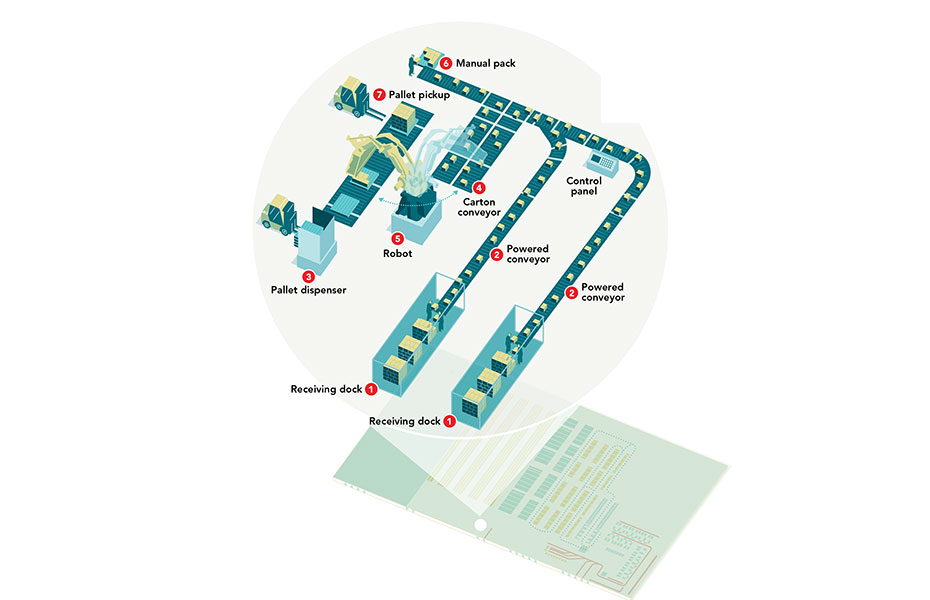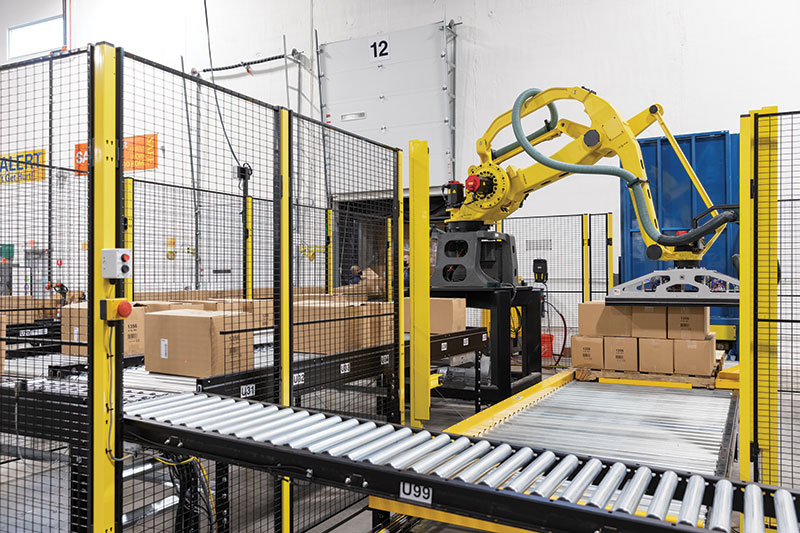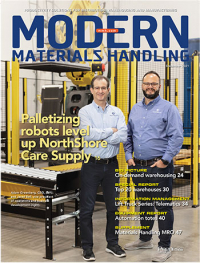Inside North Shore Care Supply: Bringing Robotic Palletizing to Receiving
Robotic palletizing is speeding up receiving at NorthShore Care Supply and minimizing the risk of worker injury.
NorthShore Care Supply
Location: Green Oaks, Ill.
Size: 173,000 square feet
Throughput: 2,500 orders per day at peak; 7,500 cartons per week
Products handled: Incontinence products such as adult diapers, pull-up style underwear and pads
SKUs: 400
Shifts per day/days per week: 1 shift, 6 days a week—varies by season and promotion
You can read the feature article on NorthShore Care Supply here.
NorthShore Care Supply is an example of a small to mid-sized company optimizing its operations and controlling its costs with automated materials handling systems. After a year of operations in a new facility, the distributor of incontinence products implemented robotic palletizing in its receiving area, an extension of the automation already in use in its picking and packing operations, including autonomous mobile robots.
For this story, we’ll focus on just the robotic palletizing. To learn how the overall system operates and for a complete list of system suppliers, be sure to read “NorthShore Care Supply optimizes processes with AMRs and carts” on mmh.com.
Unloading
The process begins when a container is backed into one of two dock positions (1). Once the telescoping conveyor is in place, two associates are assigned to unload a trailer. One of the associates scans a bar code label on a carton to alert the robot to the SKU that will be unloaded. Most containers have just one or two SKUs. Cartons are then unloaded onto the powered conveyor (2) and exit the trailer. If there is more than one SKU in a trailer, the associates unload all of the cartons associated with the first SKU, then scan the bar code label on the new carton to let the robot know a new SKU will be coming.
Pallet dispenser
Pallets to feed the robotic palletizer are loaded into a pallet dispenser (3) that can hold 20 pallets at a time. Pallets are labeled by a lift truck operator before replenishing the dispenser. Essentially two pallets are dispensed at a time: One is in place to be loaded by the robotic arm, while the second pallet waits in a queue until the first pallet is loaded and ejected. The dispenser is reloaded about every 15 pallets.
Palletizing
With a pallet in place and cartons on their way to the palletizing station, the robot analyzes how to build a pallet from pre-configured pallet patterns. The robot has a table that has the box dimensions, weight and bar code associated with each SKU. That links to a box with the pallet configuration for that SKU. The system currently has 20 pallet patterns stored in memory to handle about 100 SKUs. New SKUs can be easily added if they use an existing or similar box size. If a new box is introduced, then a new configuration has to be designed by the solution integrator. An operator determines whether the pallet should be built to a storage height for the facility or trailer height for delivery.
Cartons are diverted to one of two lanes of conveyor (4) that feed the robot (5). The robot typically picks up two cartons at a time. It can do one pick, one drop, meaning that it places two cartons on the pallet, or one pick two drops, meaning that it positions the cartons one at a time.
The solution also includes a manual palletizing area for slow-moving SKUs (6).
Putaway
Once the robot is done building a pallet, it is ejected to a pickup zone (7). Putaway is managed outside of the robotic palletizing system by a module developed in-house by NorthShore Care Supply. The system decides if the pallet is needed at a pick location or should go to storage and directs the lift truck operator to the right location.

System suppliers
- Solution design & integration: Exact Automation
- Conveyor system integration: Berken Solution
- Robotic palletizer, palletizing software & robot controller: Fanuc, including PalletPro palletizing software
- End-of-arm robotic tooling: Joulin
- Powered conveyor for trailer unloading: Caljan
- Palletizing conveyor & pallet dispenser: Omni Metalcraft Corp.
- Right angle conveyor transfers: Itoh Denki

Article Topics
Robotics News & Resources
Materials Handling Robotics: The new world of heterogeneous robotic integration 60 Seconds with Bob Trebilcock, outgoing executive editor, Modern Materials Handling Kathleen Phelps to join FORTNA as chief financial officer 2024 Intralogistics Robotics Survey: Robot demand surges Autonomous mobile robots (AMRs) on a mission Up close and personal with mind twisting special purpose robots Gartner foresees sizeable uptake for next-gen humanoid robots More RoboticsLatest in Materials Handling
Registration open for Pack Expo International 2024 Walmart chooses Swisslog AS/RS and software for third milk processing facility NetLogistik partners with Vuzix subsidiary Moviynt to offer mobility solutions for warehouses Materials Handling Robotics: The new world of heterogeneous robotic integration BSLBATT is looking for new distributors and resellers worldwide Lucas Watson appointed CSO for Körber’s Parcel Logistics business in North America Hyster recognizes Dealers of Distinction for 2023 More Materials HandlingAbout the Author
Subscribe to Materials Handling Magazine

Find out what the world's most innovative companies are doing to improve productivity in their plants and distribution centers.
Start your FREE subscription today.
April 2024 Modern Materials Handling

Latest Resources












